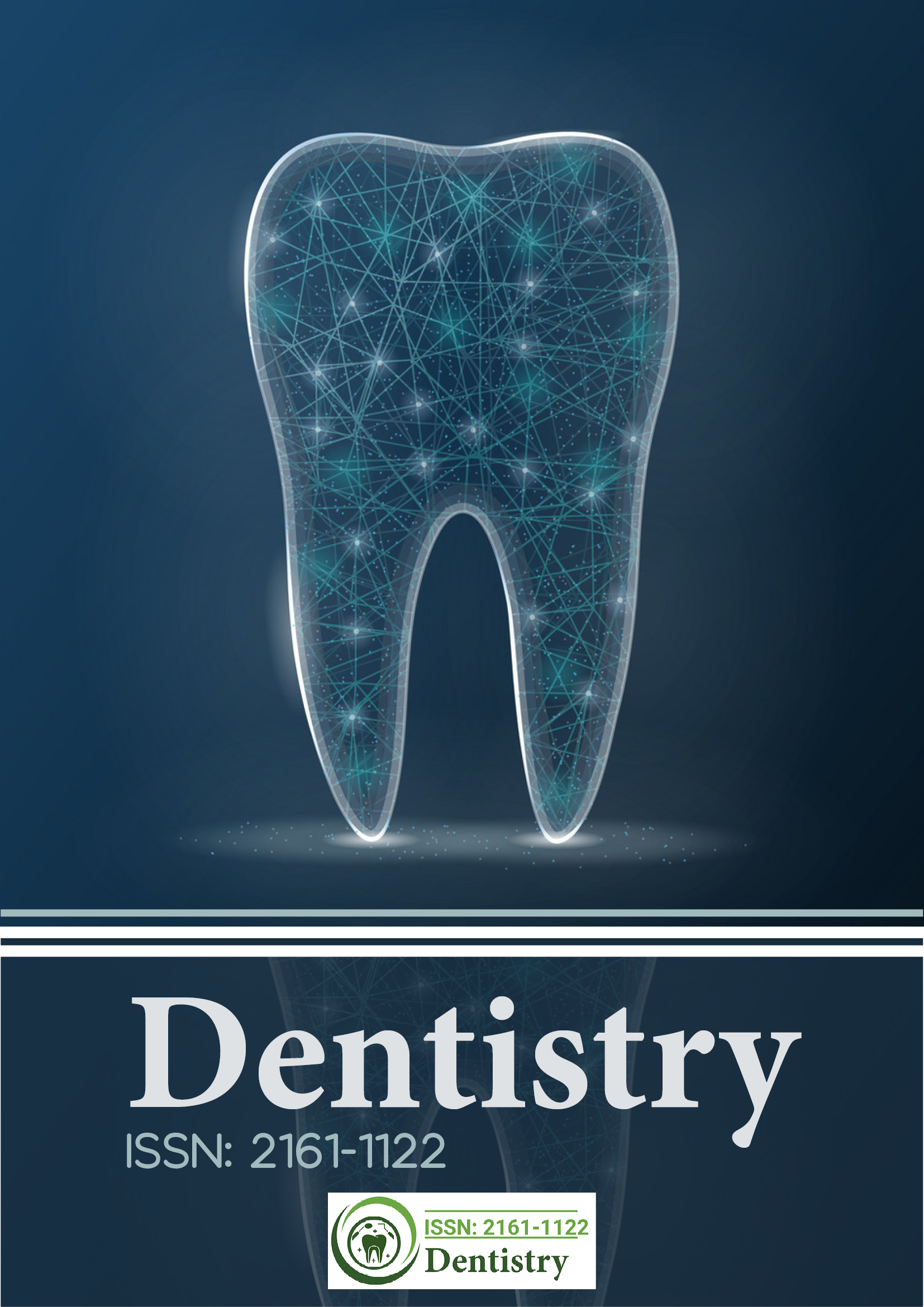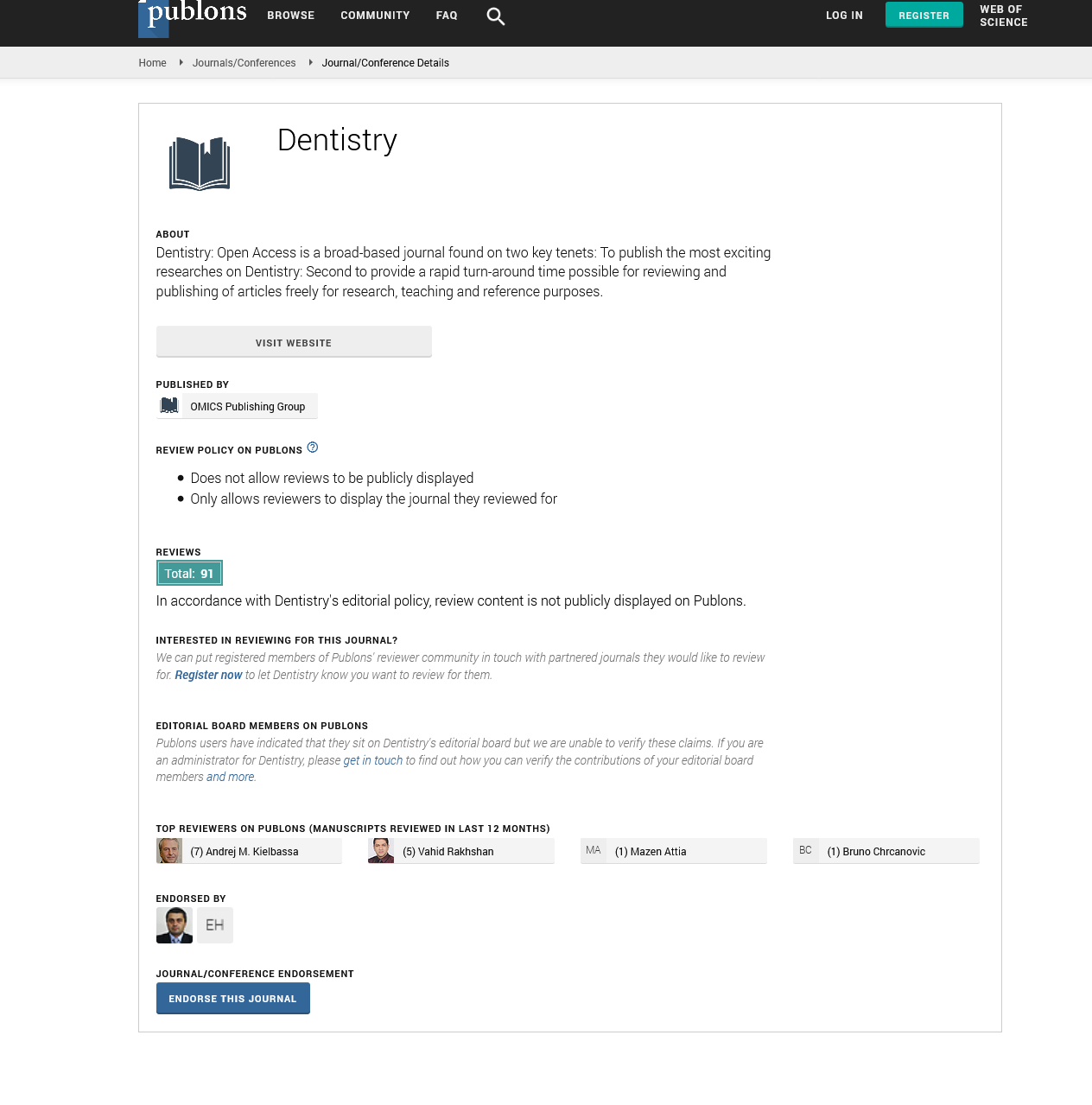Citations : 2345
Dentistry received 2345 citations as per Google Scholar report
Indexed In
- Genamics JournalSeek
- JournalTOCs
- CiteFactor
- Ulrich's Periodicals Directory
- RefSeek
- Hamdard University
- EBSCO A-Z
- Directory of Abstract Indexing for Journals
- OCLC- WorldCat
- Publons
- Geneva Foundation for Medical Education and Research
- Euro Pub
- Google Scholar
Useful Links
Share This Page
Journal Flyer

Open Access Journals
- Agri and Aquaculture
- Biochemistry
- Bioinformatics & Systems Biology
- Business & Management
- Chemistry
- Clinical Sciences
- Engineering
- Food & Nutrition
- General Science
- Genetics & Molecular Biology
- Immunology & Microbiology
- Medical Sciences
- Neuroscience & Psychology
- Nursing & Health Care
- Pharmaceutical Sciences
Perspective - (2025) Volume 15, Issue 2
Regenerative Potential of Stem Cells from Oral Tissues
Thomas Moser*, Manuscript No. DCR-25-29703; , Pre QC No. DCR-25-29703 (PQ); , QC No. DCR-25-29703; , Manuscript No. DCR-25-29703 (R); , DOI: 10.35248/2161-1122.25.15.729
Description
Stem cells derived from the oral cavity exhibit unique properties that make them suitable candidates for regenerative applications. These cells, including dental pulp stem cells, periodontal ligament stem cells and gingival mesenchymal stem cells, demonstrate self-renewal, multipotent differentiation and immunomodulatory capabilities. This review summarizes the biological characteristics, differentiation potential and therapeutic applications of oral-derived stem cells. Mechanisms governing proliferation, differentiation and interactions with the microenvironment are discussed. The article also addresses current challenges, future directions and clinical relevance of stem cells sourced from oral tissues.
The oral cavity provides a rich source of mesenchymal stem cells that can be isolated from various tissues, such as dental pulp, periodontal ligament, gingiva and exfoliated deciduous teeth. These stem cells exhibit high proliferative capacity and multipotency, allowing differentiation into osteogenic, odontogenic, adipogenic, chondrogenic and neurogenic lineages. Their accessibility, minimal invasiveness of harvest and regenerative properties make them attractive for tissue engineering, disease modeling and therapeutic interventions. Understanding the attributes of oral-derived stem cells is essential for developing safe and effective regenerative strategies in dentistry and craniofacial medicine.
Types of oral-derived stem cells
Several types of stem cells can be isolated from oral tissues, each with distinct properties and applications. Dental Pulp Stem Cells (DPSCs) are derived from the pulp tissue of permanent teeth and exhibit high proliferative and differentiation capacities. Periodontal Ligament Stem Cells (PDLSCs) originate from the ligament surrounding teeth and contribute to alveolar bone and periodontal tissue regeneration. Stem cells from Human Exfoliated Deciduous Teeth (SHED) display robust proliferation and neurogenic potential. Gingival Mesenchymal Stem Cells (GMSCs) are derived from gingival connective tissue and show immunomodulatory activity. Other sources include Apical Papilla Stem Cells (SCAP) and Dental Follicle Progenitor Cells (DFPCs), which have applications in root and periodontal regeneration.
Differentiation potential
The multipotent differentiation ability of oral stem cells is a key attribute for regenerative applications. Osteogenic differentiation leads to mineralized tissue formation, useful in craniofacial bone repair. Odontogenic differentiation supports dentin-pulp complex regeneration. Chondrogenic differentiation enables cartilage formation for temporomandibular joint repair. Adipogenic differentiation contributes to soft tissue reconstruction. Neural differentiation is observed in SHED and DPSCs, making them potential candidates for nerve regeneration in craniofacial injuries. The differentiation process is influenced by growth factors, extracellular matrix components and mechanical cues within the cellular microenvironment.
Immunomodulatory properties
Oral-derived stem cells display immunoregulatory activity that enhances their therapeutic potential. They modulate the function of T cells, B cells and macrophages, suppress inflammatory responses and promote tissue repair. GMSCs and DPSCs secrete anti-inflammatory cytokines and interact with immune cells to reduce tissue damage in inflammatory conditions. This property is advantageous for regenerative therapies in periodontitis, pulpitis and other oral inflammatory diseases.
Therapeutic applications
Stem cells from oral tissues have been explored in various regenerative and therapeutic contexts. Dental pulp stem cells and SHED have been used to regenerate pulp tissue, dentin and alveolar bone. PDLSCs contribute to periodontal tissue engineering, supporting ligament and cementum repair. GMSCs are applied in soft tissue regeneration and treatment of inflammatory conditions. Oral-derived stem cells are also used in preclinical models of craniofacial bone defects, nerve injury and tissue engineering scaffolds. Their secretome and extracellular vesicles serve as acellular therapeutic tools, offering regenerative benefits without direct cell transplantation.
Culture techniques and 3D models
Isolation and culture of oral-derived stem cells require optimized protocols to maintain viability, proliferation and differentiation potential. Conventional two-dimensional cultures are widely used, but three-dimensional culture systems provide a more physiologically relevant environment. 3D spheroids, hydrogels and scaffold-based constructs enhance cell-cell and cell-matrix interactions, promote differentiation and improve tissue formation. Co-culture with endothelial and neural cells supports vascularization and functional integration, which is critical for translational applications.
Stem cells derived from the oral cavity exhibit diverse biological attributes, including self-renewal, multipotent differentiation and immunomodulatory activity. DPSCs, PDLSCs, SHED, GMSCs and other oral stem cell populations offer potential for regenerating dental, periodontal and craniofacial tissues. Advances in culture techniques, 3D models and therapeutic strategies enhance their application in tissue engineering, disease modeling and regenerative medicine. Addressing challenges related to standardization, integration and clinical translation will support the development of effective and safe regenerative therapies using oral-derived stem cells.
Citation: Moser T (2025). Regenerative Potential of Stem Cells from Oral Tissues. J Dentistry. 15:729.
Copyright: © 2025 Moser T. This is an open-access article distributed under the terms of the Creative Commons Attribution License, which permits unrestricted use, distribution, and reproduction in any medium, provided the original author and source are credited.

